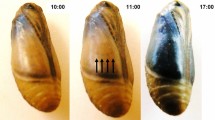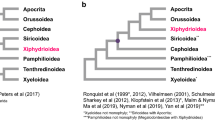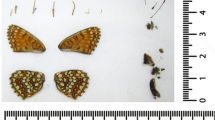Abstract
Hypolimnas misippus is a polymorphic and mimetic butterfly with a pantropical distribution. The polymorphism is autosomal and female-limited, the several female forms being generally regarded as Batesian mimics of the distasteful, toxic and polymorphic danaine butterfly Danaus chrysippus. The female phenotypes of H. misippus are described and classified. New data, from the rearing of 140 broods of H. misippus in Ghana and Sierra Leone, are analysed together with older material (21 broods) from other parts of Africa. Form misippus (genotype M−) is found to be genetically dominant to form inaria (genotype mm). However, a large proportion of mm butterflies has an intermediate phenotype, especially in association with white on the hindwing. Evidence is adduced to show that the genes giving hindwing white are variably epistatic over the ‘inaria’ pattern in the mm genotype, producing a phenotype transitional to or even identical to misippus. The various intermediate phenotypes are poor mimics of D. chrysippus: their abundance, geographical range and, hence, significance have been much underestimated.
Similar content being viewed by others
Article PDF
References
Bernardi, G. 1959. La variation géographique du polymorphisms chez les Hypolimnas du continent africain. Bulletin de l'IFAN, 21.
Clarke, C A, and Sheppard, P M. 1959. The genetics of Papilio dardanus Brown. I. Race Cenea from South Africa. Genetics, 44, 1347–1458.
Clarke, C A, and Sheppard, P M. 1960a. The genetics of Papilio dardanus Brown. II. Races Dardanus, Polytrophus, Meseres and Tibullus. Genetics, 45, 439–457.
Clarke, C A, and Sheppard, P M. 1960b. The evolution of dominance under disruptive selection. Heredity, 14, 73–87.
Clarke, C A, and Sheppard, P M. 1962. The genetics of the mimetic butterfly Papilio glaucus. Ecology, 43, 159–161.
Clarke, C A, and Sheppard, P M. 1963. Interactions between major genes and polygenes in the determination of the mimetic pattern of Papilio dardanus. Evolution, 17, 404–413.
Clarke, C A, and Sheppard, P M. 1972. The genetics of the mimetic butterfly Papilio polytes L. Phil Trans R Soc Lond B, 263, 35–70.
Clarke, C A, and Sheppard, P M. 1975. The genetics of the mimetic butterfly Hypolimnas bolina (L). Phil Trans R Soc Lond B, 272, 229–265.
Clarke, C A, Sheppard, P M, and Thornton, I W B. 1968. The genetics of the mimetic butterfly Papilio memnon L. Phil Trans R Soc Lond B, 254, 37–89.
Edmunds, M. 1969. Polymorphism in the mimetic butterfly Hypolimnas misippus L. in Ghana. Heredity, 24, 281–302.
Ford, E B. 1953. The genetics of polymorphism in the Lepidoptera. Advances in Genetics, 5, 43–87.
Ford, E B. 1975. Ecological genetics Chapman & Hall, London.
Gordon, I J. 1982. The biology of Danaus chrysippus (Lepidoptera, Danaidae) and its mimics in Ghana Ph.D. Thesis, University of Ghana.
Marsh, N A, Clarke, C A, Rothschild, M, and Kellett, D N. 1977. Hypolimnas bolina (L.), a mimic of danaid butterflies and its model Euploea core (Cram.) store cardioactive substances. Nature, 268, 726–728.
Pierre, J. 1973. Étude du polymorphisme chez Danaus chrysippus (Linné) (Lepidopére: Danaide) pour modèle et Hypolimnas misippus (Linné) (Nymphalide) pour mime. Archives de zoologie expérimentale et générale, 114, 73–96.
Pierre, J. 1976. Polymorphisme et mimétisme chez deux éspéces jumelles Acraea encedon et Acraea encedana (Lep., Acraeidae). Ann Soc Ent France (NS), 12, 621–638.
Pierre, J. 1980. Variation géographique du polymorphisme et du mimétisme de Danaus chrysippus et d' Hypolimnas misippus (lépidoptères Rhopalocères) en Afrique et en Asie. CR Soc Biogéogr, 486, 179–187.
Poulton, E B. 1908. Essays on evolution, 1889–1907. Clarendon Press, Oxford.
Smith, D A S. 1976. Phenotypic diversity, mimicry and natural selection in the African butterfly Hypolimnas misippus L. (Lepidoptera: Nymphalidae). Biological Journal of the Linnean Society, 8, 183–204.
Smith, D A S. 1984. Mate selection in butterflies: competition, coyness, choice and chauvinism. Vane-Wright, R. I. and Ackery, P. R. (eds.) Symposium of the Royal Entomological Society of London, 11, 225–244.
Unamba, J A. 1968. Ecological genetics of the butterfly Hypolimnas misippus. Ph.D. Thesis, University of Sierra Leone, Freetown.
Author information
Authors and Affiliations
Rights and permissions
About this article
Cite this article
Smith, D., Gordon, I. The genetics of the butterfly Hypolimnas misippus (L.): The classification of phenotypes and the inheritance of forms misippus and inaria. Heredity 59, 467–475 (1987). https://doi.org/10.1038/hdy.1987.157
Received:
Issue date:
DOI: https://doi.org/10.1038/hdy.1987.157



